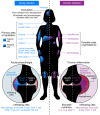Chikungunya virus: epidemiology, replication, disease mechanisms, and prospective intervention strategies
- PMID: 28248203
- PMCID: PMC5330729
- DOI: 10.1172/JCI84417
Chikungunya virus: epidemiology, replication, disease mechanisms, and prospective intervention strategies
Abstract
Chikungunya virus (CHIKV), a reemerging arbovirus, causes a crippling musculoskeletal inflammatory disease in humans characterized by fever, polyarthralgia, myalgia, rash, and headache. CHIKV is transmitted by Aedes species of mosquitoes and is capable of an epidemic, urban transmission cycle with high rates of infection. Since 2004, CHIKV has spread to new areas, causing disease on a global scale, and the potential for CHIKV epidemics remains high. Although CHIKV has caused millions of cases of disease and significant economic burden in affected areas, no licensed vaccines or antiviral therapies are available. In this Review, we describe CHIKV epidemiology, replication cycle, pathogenesis and host immune responses, and prospects for effective vaccines and highlight important questions for future research.
Conflict of interest statement
Figures



References
-
- Carey DE. Chikungunya and dengue: a case of mistaken identity? J Hist Med Allied Sci. 1971;26(3):243–262. - PubMed
Publication types
MeSH terms
Grants and funding
LinkOut - more resources
Full Text Sources
Other Literature Sources
Medical

